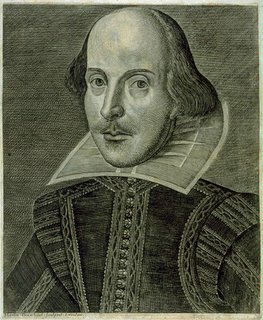
Grafton portrait

Droeshout engraving

The British National Portrait Gallery has concluded a six-year study aimed at deciding which, if any, of the purported images of William Shakespeare are genuine portraits. According to this news release, the Chandos portrait is the last bard standing.
I'm in no position to gainsay the experts, but I much prefer the Grafton portrait. (I didn't find a good scan of the restored image of any size online, sorry.) It is named after an 18th century duke of that name, in whose possession it first enters recorded history. It was disqualified mainly because the silk and satin wardrobe of the young man would have been too sumptious for someone in Shakespeare's financial condition at the time it was painted. There's also the matter of paying the portraitist. But I'm in the middle of reading Peter Ackroyd's Shakespeare: The Biography, and I'm mightily swayed by his attraction to that image. He persuasively speculates that, instead of being just a struggling actor in 1588, Shakespeare was quite the up-and-comer; At that time he may have been making an impression as a reviser of other dramatists' plays, and also dashing off plays of his own, which are now lost. Even if he wasn't yet well-off, a young man with an initial taste of success might certainly have over-spent his means, by acquiring some fashionable duds. This may well explain why Shakespeare was seemingly so grasping about money later in life, after he learned his lesson.
We can't expect photographic uniformity among portraits of people from that era, of course. Just look at these images of Queen Elizabeth--could you be sure that they were all of the same woman, if you didn't already know? But the eyes and the mouth of the Grafton portrait are a close match to the Droeshout engraving--which itself must have been copied from a portrait, as Shakespeare died when Martin Droeshout was fifteen. Yes, the nose is different, more W.C. Fieldsy than aquiline. But just look at that knowing gaze for a few seconds....
First Things has published a number of good Shakespeare articles over the years. His plays have been deployed as a critique of modern multiculturalism. And the staggering height of his fame has been duly lauded, along with the crypto-Catholic allusions found in his home life and associations.

I rather prefer the Chandos portrait, probably because I have seen it most often in my studies. :) Very interesting post!
ReplyDelete